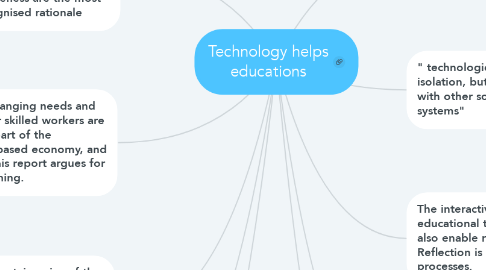Technology helps educations
by Erika Flash

1. Among the multiple reasons and motives why universities engage with e-learning or online learning, widening access, increasing flexibility and cost-effectiveness are the most widely recognised rationale
1.1. Technological development is therefore singled out as the most important factor in initiating and expanding distance, online and blended learning, where the educational process is mainly facilitated by educational technologies
2. The rapid changing needs and demands for skilled workers are an integral part of the knowledge-based economy, and therefore, this report argues for lifelong learning.
2.1. This means that ongoing training and learning is needed to be an active participant in a competitive, global knowledge-based economy.
2.1.1. Because the application of technology is an integral part of education in such economy, technology adoption is strongly linked to the education of the labour force.
3. One of the certain gains of the advent of technology in education is that it stimulated much needed in-depth discussions and caused teachers to rethink their pedagogical models
3.1. New technology allows for new ways to present information.
4. participation is better in online education.
4.1. Classroom-based education often provides a forum for extrovert learners to participate, while introverts find it difficult to participate, resulting in difficulty in allocating marks for participation. Online education, however, provides an environment where all and often marginalised voices could be heard, contributing to a higher participation of students as well as collaborative learning.
5. the integration of technology into education could meet the needs of the Millennials as the generation currently attending universities
5.1. This generation prefers this method better because it helps them learn more efficiently.
6. "understanding of the nature of the medium is required before designing it as educational environment."
6.1. If one doesn't understand how to use the medium of technology, then technology hinders learning rather than aiding it.
7. " technologies do not operate in isolation, but are intertwined with other social and cultural systems"
7.1. technology lock in’, which occurs when economy and culture coalesce with technology systems around a particular way of doing something
8. The interactive nature of educational technology could also enable reflective practices. Reflection is key in all learning processes.
8.1. ‘A change agent is someone whose presence and/or thought processes cause an alteration from the traditional or conventional way of handling and thinking about an issue’
9. The fluid nature of technology in online education, where time and spaces do not limit connection, creates an environment where students have to take greater responsibility for their own learning process and continuous participation is more the norm than the exception
9.1. Students’ feedback indicates that the course makes them aware of their social responsibilities as citizens, as well as to assist with the integration of what they believe into their everyday living
10. More money is being spent on technology
10.1. The newfound money should be put to proper use in education.



